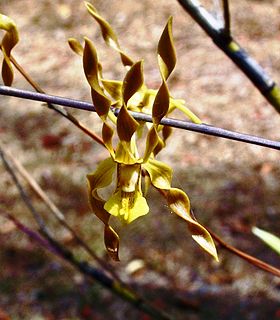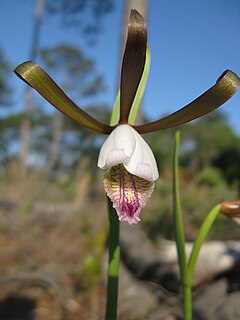
The Orchidaceae are a diverse and widespread family of flowering plants, with blooms that are often colourful and fragrant, commonly known as the orchid family.

The stamen is the pollen-producing reproductive organ of a flower. Collectively the stamens form the androecium.

Bulbophyllum is a genus of mostly epiphytic and lithophytic orchids in the family Orchidaceae. It is the largest genus in the orchid family and one of the largest genera of flowering plants with more than 2,000 species, exceeded in number only by Astragalus. These orchids are found in diverse habitats throughout most of the warmer parts of the world including Africa, southern Asia, Latin America, the West Indies, and various islands in the Indian and Pacific Oceans. Orchids in this genus have thread-like or fibrous roots that creep over the surface of trees or rocks or hang from branches. The stem is divided into a rhizome and a pseudobulb, a feature that distinguished this genus from Dendrobium. There is usually only a single leaf at the top of the pseudobulb and from one to many flowers are arranged along an unbranched flowering stem that arises from the base of the pseudobulb. Several attempts have been made to separate Bulbophyllum into smaller genera, but most have not been accepted by the World Checklist of Selected Plant Families.

Cephalanthera rubra, known as red helleborine, is an orchid found in Europe, North Africa and southwest Asia. Although reasonably common in parts of its range, this Cephalanthera has always been one of the rarest orchids in Britain.

Neotinea ustulata is a European terrestrial orchid native to mountains in central and southern Europe, growing at up to 2,400 m (7,900 ft) elevation. The plant is considered Endangered in Great Britain and Least Concern internationally based on IUCN Red List criteria. The burnt-tip orchid was voted the county flower of Wiltshire in 2002 following a poll by the wild flora conservation charity Plantlife.

Epidendrum nocturnum is the type species of the genus Epidendrum of the Orchidaceae . The species occurs in Florida, Bahamas, West Indies, Central America to northern Brazil and the Guyanas. Epidendrum nocturnum is common in South Florida.

Coelogyne flaccida is a species of orchid that is native to southeast Asia and northeastern South Asia. Cultivated as an ornamental plant, it is also known as the bearded Coelogyne and the loose Coelogyne.

Bulbophyllum baileyi, commonly known as the fruit fly orchid, is a species of epiphytic or lithophytic orchid that is native to Queensland and New Guinea. It has coarse, creeping rhizomes, curved, yellowish pseudobulbs with a single thick, fleshy leaf, and a single cream-coloured flower with yellow, red or purple spots. It grows on trees and rocks in open forest, often in exposed places.

Bulbophyllum minutissimum, commonly known as the red bead orchid or grain-of-wheat orchid, is a species of epiphytic or lithophytic orchid with small, flattened, reddish or green pseudobulbs, scale-like leaves and small whitish to reddish flowers with broad dar red stripes. It grows on trees and rocks, mostly in swamps and near streams in eastern Australia.
Bulbophyllum nematopodum, commonly known as the green cowl orchid, is a species of epiphytic or lithophytic orchid that has small, flask-shaped pseudobulbs pressed against the surface on which it grows. Each pseudobulb has roots at its base, a single shiny, fleshy leaf and a single cream-coloured flower with red spots on its top. It grows on trees and rocks in rainforest and is endemic to tropical North Queensland.

Dendrobium johannis, commonly known as the chocolate tea tree orchid, is a species of epiphytic or lithophytic orchid native to Australia and New Guinea. It has spindle-shaped pseudobulbs, between five and ten dark green leaves with purplish markings and flowering stems with up to fifteen chocolate brown flowers with a yellow labellum.

Dendrobium trilamellatum, commonly known as the fragrant tea tree orchid or large tea tree orchid, is a species of epiphytic orchid found in northern Australia and New Guinea. It has spindle-shaped pseudobulbs, between three and seven leathery, dark green leaves and between three and fifteen yellow, yellowish brown or brown flowers with a mauve to purple labellum.

Cattleya rex is a species of epiphytic orchid of showy white flowers, native to montane forests in Peru and Bolivia.

Lyperanthus, commonly known as beak orchids, is a genus of flowering plants from the orchid family, Orchidaceae, that is endemic to Australia. There are two species, one in Western Australia and the other in four eastern Australian states, distinguished by their single long, narrow, leathery leaf and dull coloured flowers which have prominent short calli on their labellum. Both form loose colonies which reproduce asexually from their tubers, and sexually using their flowers.

Caleana, commonly known as duck orchids, is a genus of flowering plants in the orchid family, Orchidaceae that is found in Australia and New Zealand. The Australian species are found in all states but have not been recorded in the Northern Territory. Duck orchids have a single leaf and one or a few, dull-coloured, inconspicuous flowers. Most species are found in Western Australia but one species occurs in eastern Australia and one occurs in eastern Australia and New Zealand. Orchids in this genus as well as the hammer orchids (Drakaea) are pollinated by male thynnid wasps.

Cleistesiopsis is an orchid genus in the tribe Pogonieae. Its members were included in Cleistes until 2009. Cleistesiopsis is native to the eastern and southeastern United States from New Jersey south to Florida, and west to Kentucky and Louisiana. The common names are rosebud orchid and small spreading pogonia.
André Schuiteman is a Dutch botanist in the Royal Botanic Gardens, Kew in London, United Kingdom, where he is the Research Leader for Asia in Plant Identification and Naming. Schuitemania, a genus of orchid, was named in his honour.
Caladenia abbreviata, commonly known as the coastal spider orchid, is a plant in the orchid family Orchidaceae and is endemic to the south-west of Western Australia. It has a single erect, hairy leaf and up to three pale, creamy-yellow flowers on a flowering stem up to 35 cm (10 in) high. Although the flowers have long, thread-like petals and sepals, they are shorter and darker than those of other spider orchids. It is a rare, relatively recently discovered species although often found near human activities.
Pterostylis timorensis is a plant in the orchid family Orchidaceae and is endemic to East Timor. Both flowering and non-flowering plants have a rosette of light green, fleshy leaves. Flowering plants have a single green, white and reddish-brown flower and two or three stem leaves.

Bulbophyllum maxillare, commonly known as the red horntail orchid, is a species of epiphytic orchid with tapered grooved, dark green to yellowish pseudobulbs, each with a single large, thin leaf and a single reddish flower with yellow or white edges. The lateral sepals are much larger than the dorsal sepal which in turn is much larger than the petals. It grows on the lower branches of rainforest trees in India, New Guinea and tropical North Queensland.
















